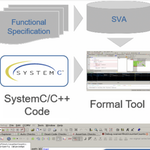January 12, 2022
Automated formal technologies can be used to ease the debug and functional verification burden of SystemC/C++ code prior to high-level synthesis. This tutorial, first presented at DVCon Europe explores how these formal techniques can be deployed and provides real-world examples.
August 31, 2017
Doc Formal concludes his introduction to formal verification with a practitioner's view of the technology.
January 5, 2016
Using formal property verification to prove that SoCs can’t do the wrong thing, as well as that they will do the right thing.
June 30, 2015
Considering design style, assertions, engines and coverage can help ease the development of an effective formal verification test plan
May 29, 2015
Research study suggests the maturity of your verification flow determines the likelihood of first-pass success far more than the complexity inherent in design size.
January 20, 2015
Combining assertion-based verification techniques with emulation makes for easier debug, better coverage and greater functional efficiency.
December 14, 2010
Assertions and assertion-based verification (ABV) are hot topics, but many engineering teams remain unfamiliar with the benefits they bring to the design and verification process. This article discusses the rationale behind them, the value they bring across the design and verification process, and offers a step-by-step approach to implementing them.
September 10, 2010
Timing closure is a key challenge for today’s complex system-on-chip designs. Static timing analysis (STA) tools automatically analyze signal paths in a design and identify timing-critical paths that limit the clock frequency that can be achieved. Paths that can never be functionally activated or that require multiple cycles for correct operation can be identified as [...]
May 1, 2009
The article describes a dedicated low-power functional verification methodology, originally developed at STMicroelectronics (now ST-Ericsson). The article details the content, sequence and effectiveness of the methodology as it was tested on a 45nm system-on-chip design. In order of use, the main components are: A high-level verification language testbench Formal verification Rule checking C function library […]
March 2, 2009
Today’s system-on-chip designs often need to encompass multiple asynchronous clocks. This raises the problem of verification for the resultant clock domain crossings. It is becoming apparent that functional simulation alone is not up to the task. Instead, engineers need to consider hybrid methodologies, combining structural and functional verification approaches. The use of assertions is also […]








